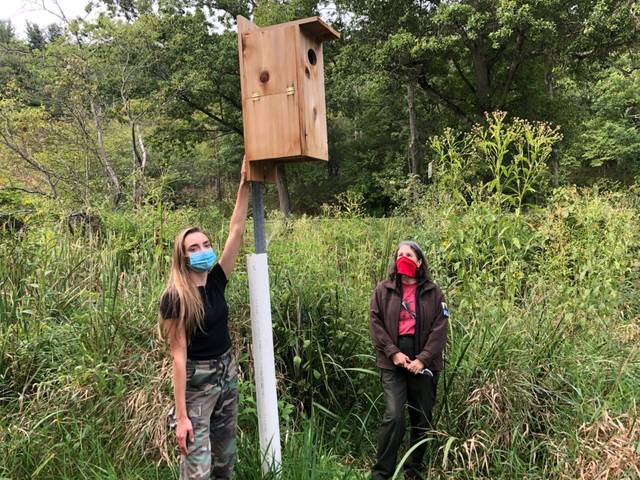https://triblive.com/local/a-pine-richland-senior-has-gone-to-the-birds-for-a-girl-scout-gold-award/
Pine-Richland senior has gone to the birds for Girl Scout Gold Award

A Pine-Richland High School senior and longtime Girl Scout’s latest project is for the birds.
Katrina Schwab of Troop 55094 in Wexford constructed six wood duck boxes for the Latodami Nature Center in North Park.
Boxes were installed in different parts of the park’s 3,000-plus acres, including one along Pine Creek.
“It’s the only park that we have, and a lot of people use it,” Katrina, 17, said. “I think it’s important that we keep it the way it is so future generations can enjoy it.”
The project is for her Gold Award, the highest achievement in Girl Scouts. It was recently reviewed by the Girl Scouts of Western Pennsylvania.
The family said they received a letter of approval, and the award is expected to be given at a ceremony next April .
The wood duck is one of the most recognizable birds in the country. Males have red eyes and a red bill with a yellow patch at its base, according to the National Wildlife Federation. The top of the bird’s head and crest are a metallic purplish-green, and its chest is dark red. Its tail and back are black, and its wings are black and blue.
NWF officials said the birds live year ’round in the Southeast and along the Pacific Coast.
About Katrina’s project
The boxes are about 3 feet tall and nearly a foot wide. They were made from cedar lumber and posted about 9 feet off the ground on metal poles. White plastic piping acts as a predator barrier to stop raccoons, squirrels and other animals from climbing up to the boxes.
“It’s like a bird house but for ducks, so they’re very large,” Katrina said. “For this project, I was able to communicate it to younger girls.”
Katrina showed leadership by instructing others on how to build duck boxes at a workshop in July.
“It was kind of nerve-wracking for me because I’m quiet,” Katrina said. “I really had to step out of my comfort zone and talk to lots of people.”
She also made a video about the duck boxes for those who couldn’t attend the workshop.
The video was posted to the Friends of Latodami’s Facebook page.
Her Girl Scout journey
Katrina said her project would not have been possible without the support of friends and family such as her mother, Cindy Schwab.
Schwab said the Girl Scouts has done wonders for daughter.
“You go to different places. You meet different girls. You make new friends,” she said. “You also make friends with kids who you normally don’t see in school or hang out with. I think it’s made her more of an outdoor gal. I hate the outdoors, and she likes it.”
Katrina has been in Scouts since second grade. She earned a Bronze Award for planting trees and cleaning up different areas in North Park. Her Silver Award project was making little houses for cats out of fish coolers from Pet Smart for the Butler County Humane Society.
No duck boxes, no wood ducks
The duck box project began in December 2018 as part of discussions with the center’s interpretive naturalist, Meg Scanlon.
“Without these nest boxes these birds would not exist in the park,” said Scanlon. “It’s a great benefit to the region.
“The interesting thing about wood ducks is they will make use of other boxes. In locations throughout the park we have not only wood duck boxes but screech owl and bard owl boxes. They do not necessarily have to be near streams.”
Duck boxes were first installed in North Park in the early 1970s by naturalist Joe Grom.
There are about 30 boxes of the aforementioned types still in use in the park, including Katrina’s contribution.
Scanlon was present for Katrina’s workshop.
“I was impressed with the confidence she showed,” Scanlon said. “The organizational components and having the boxes already pre-cut and laid out in little kits, and placed so people could group themselves for the construction of the boxes.”
The boxes are expected to last at least 10 years. There’s a door on the side for easy maintenance and wire mesh inside so baby birds can climb up and get out.
Rich Fanaro is the Pennsylvania state chairman for Ducks Unlimited, an international conservation and restoration nonprofit.
He echoed Scanlon’s comments about the need for duck boxes, and commended Katrina’s efforts.
“Duck boxes are really important,” Fanaro said. “They protect against predators. I think it’s a great opportunity for kids to understand it. It’s a great thing for kids to be involved with. It’s great to see kids get outside.”
Fanaro said the key to having the boxes last for years is annual maintenance. He recommend people clean them out in January or February and put in about three to four inches of fresh wood chips.
There are about 16,000 Ducks Unlimited members and 44 chapters in the state.
The charity has a tutorial on how to create a wood duck box. More information about the organization is available at ducks.org.
Copyright ©2025— Trib Total Media, LLC (TribLIVE.com)
